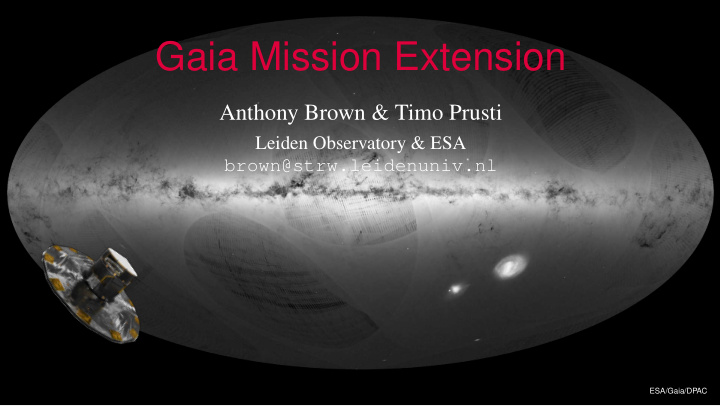



Gaia Mission Extension Anthony Brown & Timo Prusti Leiden Observatory & ESA brown@strw.leidenuniv.nl ESA/Gaia/DPAC
Gaia ● Astrometry and spectrophotometry for > 1 billion objects ● Radial velocities for > 100 million objects ● Survey Complete to G = 20 . 7 ( V = 20–22) ◮ Quasi-regular time-sampling over 5 years ◮ ( ∼ 70 observations) ● Launch December 2013 ● 5 years of operations at L2 ◆ First data release Sep 2016 Gaia DR2 April 2018 ◮ ◆ Photometric alerts started in 2014 ◆ Alerts on new solar system objects started end 2016 Lund - 2017.08.31 - 2/16
1-2]Gaia Sky ESA/Gaia/DPAC
1-2]Gaia Sky ESA/Gaia/DPAC
Gaia extension ● Nominal Gaia mission ends mid-2019 after 5 years of measurements ● Hardware and operations designed for a 5-year survey for sky homogeneity ● Scientifically the best option is to start a new 5-year survey on top of the nominal 5-year survey Notes on continued S/C operations ◆ All hardware in good shape ◆ Only limiting factor is micro-propulsion system fuel ◆ Estimated to run out by mid 2024 Berry Holl Lund - 2017.08.31 - 5/16
Improvement of scientific performance ● Basic mission results improve with t − 0 . 5 Positions, parallaxes, photometry and radial velocities ◮ ● Rapidly increasing gain in kinematics and dynamics Proper motion improvement scales as t − 1 . 5 ◮ More complex systems scale faster, e.g. improvement in unambiguous determination of orbital period, ◮ mass and distance of a perturbing body scales as t − 4 . 5 Improvement factor for mission Distance increase at the Volume increase at the length increase from 5 to 10 years same accuracy same accuracy Parallax 1 . 4 2 . 8 Proper motion 2 . 8 23 Lund - 2017.08.31 - 6/16
Parallax improvement ● At a given magnitude 40% improvement is achieved OR ● Same performance can be achieved for 0 . 5 mag fainter objects Lund - 2017.08.31 - 7/16
Solar system ● For the main belt asteroids, Hildas and Trojans the huge improvement is related to covering a larger fraction of the orbit ● Masses from close encounters ● Improvement of stellar catalogues allow re-calibration of old images and plates Lund - 2017.08.31 - 8/16
Exoplanets ● Gaia’s strength is Neptune-Jupiter mass planets around stars ● Mission extension reveals population of giant planets above several AU distances from the parent star giant planets before migration, systems with giant ‘guarding’ habitable zone ◮ ● Exoplanets research gains enormously from the improved parallaxes helping to describe the host star Lund - 2017.08.31 - 9/16
Stars and stellar clusters ● Factor ∼ 8 more clusters ● Reach inner and Perseus spiral arms ● Reach larger diversity of environments and cluster types ● Probe low stellar masses at larger distances Lund - 2017.08.31 - 10/16
Structure and evolution of the Milky Way Galaxy ● Internal kinematics of local group galaxies ● Brightest populations in classical dwarf galaxies at ∼ 100 kpc only reachable with 5 yr extension Lund - 2017.08.31 - 11/16
Structure and evolution of the Milky Way Galaxy ● Larger volume reached throughout the halo at given proper motion accuracy ● Tidal streams detection improvement ● Probe young and unmixed debris located beyond 20–30 kpc ● Calibration of photometric distance indicators on nearby samples ⇒ full gain in tangential motion performance Lund - 2017.08.31 - 12/16
Fundamental physics ● Gravitational waves Low to ultra-low frequency ◮ Lund - 2017.08.31 - 13/16
Reference frames ● Reference frame degradation is due to proper motion errors ● Mission extension improves proper motions quicker than parallaxes ● 30–40 m class telescopes reference frame ● Practically everything in the past limited by accuracy of reference stars will be limited by precision of the data itself Lund - 2017.08.31 - 14/16
Other example science cases ● Near Earth Objects ● Variability of sources over decade time scale ● Double stars with 5–10 year orbits ● Distance ladder improvements with Cepheids and RR Lyrae ● Solar system (barycentre) motion around the Galactic centre ● Jupiter quadrupole moment ◆ Target selection for exoplanet missions ◆ Euclid and LSST time overlap synergies Lund - 2017.08.31 - 15/16
● Gaia provides fundamental data with long lasting legacy and impacting all fields of astronomy ● Extension is first opportunity to go ‘beyond Gaia’ ● The expected science justifies extension, while the unexpected may be even more exciting
Recommend
More recommend